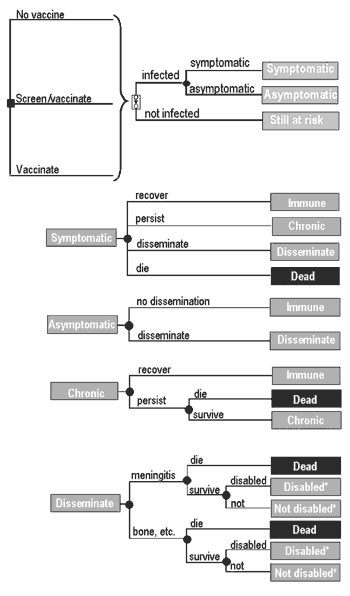Volume 7, Number 5—October 2001
Synopsis
Cost-Effectiveness of a Potential Vaccine for Coccidioides immitis
Figure 2

Figure 2. . Schematic representation of the decision model and decision model subtrees. The square node represents a decision to use one of the three strategies: no vaccination, vaccination of susceptible persons identified through a screening skin test, or vaccination of all persons. Circles represent chance nodes. After a strategy is chosen, the patient enters a Markov tree (denoted by a rectangle containing circles connected by an arrow). The Markov tree represents clinical events that can occur during each 1-month period as a patient is followed until death. Subtrees show events that may occur to patients during a 1-month cycle. Dissemination subtree: The site of extrapulmonary dissemination can be to the brain (meningitis) or elsewhere (e.g., bone). The outcome of dissemination can be death from other causes, death from disseminated coccidioidomycosis, or survival. If the patient survives, he or she can survive in a disabled or nondisabled state. Each month thereafter, the patient is at risk for relapse. Chronic subtree: Each month a patient with chronic pulmonary coccidioidomycosis can die from other causes, remain infected, die from chronic pulmonary infection, or be cured and rendered immune. Immune subtree: On any given month, a patient who is immune to infection can die of other causes or remain alive and immune to coccidioidomycosis.